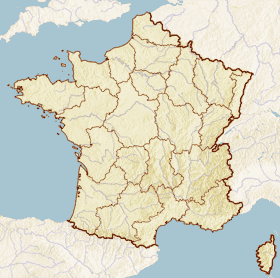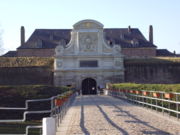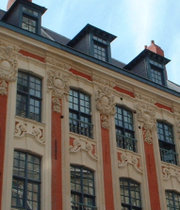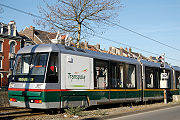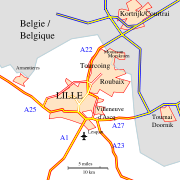Lille
2008/9 Schools Wikipedia Selection. Related subjects: Europe; European Cities
| Ville de Lille | ||
|
 |
|
| New city flag | Traditional coat of arms | |
|
Motto: – |
||
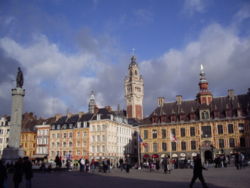 |
||
| Place du Général de Gaulle, also known as 'Grand'Place' | ||
| Location | ||
|
||
| Time Zone | CET (GMT +1) | |
| Coordinates | ||
| Administration | ||
|---|---|---|
| Country | France | |
| Region | Nord-Pas de Calais | |
| Department | Nord (59) | |
| Intercommunality | Urban Community of Lille Métropole |
|
| Mayor | Martine Aubry ( PS) (2008-2014) |
|
| City Statistics | ||
| Land area¹ | 39.51 km² | |
| Population² (2004 estimate) |
226 800 | |
| - Ranking | 10th in France | |
| - Density | 5 740/km² (2004 ) | |
| Urban Spread | ||
| Urban Area | 450 km² (1999 ) | |
| - Population | 1 000 900 (1999 ) | |
| Metro Area | 975 km² (1999 ) | |
| - Population | 1 143 125 (1999 ) | |
| 1 French Land Register data, which excludes lakes, ponds, glaciers > 1 km² (0.386 sq mi or 247 acres) and river estuaries. | ||
| 2 Population sans doubles comptes: residents of multiple communes ( e.g. students and military personnel) only counted once. | ||
Lille (IPA: [lil]; Dutch: Rijsel) is a city in northern France. It is the principal city of the Lille Métropole, the fourth-largest metropolitan area in the country behind those of Paris, Lyon and Marseille. Lille is situated on the Deûle River, near France's border with Belgium. It is the capital of the Nord-Pas de Calais region and the préfecture of the Nord department.
The city of Lille, which annexed Lomme on February 27, 2000, had a population of 226,800 at the 2005 census. Meanwhile, the Lille Métropole, which also includes Roubaix, Tourcoing and numerous suburban communities, had a population of 1,091,438. The eurodistrict of Lille-Kortrijk, which also includes the area the Belgian cities of Kortrijk, Tournai, Mouscron and Ypres, had 1,885,000 residents.
History
Origin of the city
The legend of " Lydéric and Phinaert" puts the foundation of the city of "L'Isle" at 640. Although the first mention of the town appears in archives from the year 1066, some archeological digs seem to show the area as inhabited by as early as 2000 BC, most notably in the modern-day quartiers of Fives, Wazemmes, and Old Lille.
The name Lille comes from insula or l'Isla, since the area was at one time marshy. This name was used for the Counts of Flanders' castle, built on dry land in the middle of the marsh. The Count of Flanders controlled a number of old Roman cities ( Boulogne, Arras, Cambrai) as well as some founded by the Carolingians ( Valenciennes, Saint-Omer, Ghent, Bruges). The County of Flanders thus extended to the left bank of the Scheldt, one of the richest and most properous regions of Europe. The original inhabitants of this region were the Gauls, such as the Menapians, the Morins, the Atrebates, and the Nervians, who were followed by Germanic peoples, the Saxons and the Frisians, and the Franks later. From 830 until around 910, the Vikings invaded Flanders. After the destruction caused by Norman and Magyar invasion, the eastern part of the region fell under the eyes of the area's princes.
Middle ages
A local notable in this period was Evrard, who lived in the 9th century and participated in many of the day's political and military affair.
From the 12th century, the fame of the Lille cloth fair began to grow. In 1144 Saint Sauveur parish was formed, which would give its name to the modern-day quartier Saint-Sauveur.
The counts of Flanders, Boulogne, and Hainaut came together with England and the Holy Roman Empire of Germany and declared war on France and Philip II of France, a war that ended with the French victory at Bouvines in 1214. Infante Ferdinand, Count of Flanders was imprisoned and the county fell into dispute: it would be his wife, Jeanne, Countess of Flanders and Constantinople, who ruled the city. They say she was well-loved by the residents of Lille, who by that time numbered 10,000.
In 1224, the monk Bertrand of Rains, doubtlessly encouraged by local lords, tried to pass himself off as Baldwin I of Constantinople (the father of Jeanne of Flanders), who had disappeared at the battle of Adrianople. He pushed the kingdoms of Flanders and Hainaut towards sedition against Jeanne in order to recover his land. She called her cousin, Louis VIII ("The Lion"). He unmasked the imposter, whom Countess Jeanne quickly had hanged. In 1226 the King agreed to free Infante Ferdinand, Count of Flanders. Count Ferrand died in 1233, and his daughter Marie soon after. In 1235, Jeanne granted a city charter by which city governors would be chosen each All Saint's Day by four commissioners chosen by the ruler. On February 6th, 1236, she founded the Countess's Hospital ( L'hospice de la comtesse), which remains one of the most beautiful buildings in Old Lille. It was in her honour that the hospital of the Regional Medical University of Lille was named "Jeanne of Flanders Hospital" in the 20th century.
The Countess died in 1244 in the Abbey of Marquette, leaving no heirs. The rule of Flanders and Hainaut thus fell to her sister, Margaret II, Countess of Flanders, then to Marguerite's brother, Guy of Dampierre. Lille fell under the rule of France from 1304 to 1369, after the battle of Mons-en-Pévèle.
The county of Flanders fell to the Duchy of Burgundy next, after the 1369 marriage of Margaret III, Countess of Flanders, and Philip the Bold, Duke of Burgundy. Lille thus became one of the three capitals of said Duchy, along with Brussels and Dijon. By 1445, Lille counted some 25,000 residents. Philip the Good, Duke of Burgundy, was even more powerful than the King of France, and made Lille an administrative and financial capital.
On February 17, 1454, one year after the taking of Constantinople by the Turks, Philip the Good organised a Patagruelian banquet at his Lille palace, the still-celebrated " Feast of the Pheasant". There the Duke and his court undertook an oath to Christianity.
In 1477, at the death of the last duke of Burgundy, Charles the Bold, Mary of Burgundy married a Hapsburg, Maximilian of Austria, who thus became Count of Flanders. At the end of the reign of the Holy Roman Emperor Charles V, Spanish Flanders fell to his eldest son, and thus under the rule of Philip II of Spain, King of Spain. The city remained under Spanish rule until the reign of Philip IV of Spain.
The modern era
The 16th century was marked, above all, by the outbreak of the Plague, a boom in the regional textile industry, and the Protestant revolts.
The first Calvinists appeared in the area in 1542; by 1555 there was anti-Protestant repression taking place. In 1578, the Hurlus, a group of Protestant rebels, stormed the castle of the Counts of Mouscron. They were removed four months later by a Catholic Wallon regiment, after which they tried several times between 1581 and 1582 to take the city of Lille, all in vain. The Hurlus were notably held back by the legendary Jeanne Maillotte. At the same time (1581), at the call of Elizabeth I of England , the north of the Southern Netherlands, having gained a Protestant majority, successfully revolted and formed the United Provinces.
In 1667, Louis XIV of France (the Sun-King) successfully laid siege to Lille, resulting in it becoming French in 1668 under the Treaty of Aix-la-Chapelle, provoking discontent among the citizens of the prosperous city. A number of important public works undertaken between 1667 and 1670, such as the Citadel (erected by Vauban), or the creation of the quartiers of Saint-André and la Madeleine, enabled the King to gradually gain the confidence of his Lille subjects, who continued to feel Flemish, though they had always spoken the French Picard dialect.
During five years, from 1708 to 1713, the city was occupied by the Dutch, during the War of the Spanish Succession. Throughout the 18th century, Lille remained profoundly Catholic, which explains why the city did not really take part in the French Revolution, though there were riots and the destruction of churches. In 1790, the city held their first municipal elections.
After the French Revolution
In 1792, in the aftermath of the French Revolution, the Austrians, then in the United Provinces, laid siege to Lille. The " Column of the Goddess", erected in 1842 in the "Grand-Place" (officially named La Place du Général de Gaulle), is a tribute to the city's resistance, led by Mayor François André. Although Austrian artillery destroyed many houses and the main church of the city, the city did not surrender and the Austrian army left after eight days.
The city continued to grow, and by 1800 held some 53,000 residents, leading to Lille becoming the county seat of the Nord départment in 1804. In 1846, a rail line connecting Paris and Lille was built.
At the beginning of the 19th century, Napoleon I's continental blockade against the United Kingdom led to Lille's textile industry developing itself even more fully. The city was known for its cotton, and the nearby towns of Roubaix and Tourcoing worked wool.
In 1853, Alexandre Desrousseaux composed his famous lullaby Dors mon p'tit quinquin. In 1858, an imperial decree led to the annexation of the adjacent towns of Fives, Wazemmes, and Moulins. Lille's population was 158,000 in 1872, growing to over 200,000 by 1891. In 1896 Lille became the first city in France to be led by a socialist, Gustave Delory.
By 1912, Lille's population was at 217,000: the city profited from the Industrial Revolution, particularly via coal and the steam engine. The entire region had grown wealthy thanks to the mines and to the textile industry.
World War I
From October 4th to 13th, 1914, the troops in Lille were able to trick the enemy by convincing them that Lille possessed more artillery than was the case; in reality, the city had only a single cannon. Despite the deception, the German bombardments destroyed over 2,200 buildings and homes. When the Germans realized they had been tricked, they burned down an entire section of town, subsequently occupying the city. Lille was liberated by the British on October 17th, 1918, when General Sir William Birdwood and his troops were welcomed by joyous crowds. The general was made an honorary citizen of the city of Lille on October 28th of that year.
The Années Folles, the Great Depression, and the Popular Front
In July 1921, at the Pasteur Institute in Lille, Albert Calmette and Camille Guérin discovered the first anti-tuberculosis vaccine, known as BCG ("Bacille de Calmette et Guérin"). The Opéra de Lille, designed by Lille architect Louis M. Cordonnier, was dedicated in 1923.
From 1931 Lille felt the repercussions of the Great Depression, and by 1935 a third of the city's population lived in poverty. In 1936, the city's mayor, Roger Salengro, became Minister of the Interior of the Popular Front, eventually killing himself after right-wing groups led a slanderous campaign against him.
World War II
Lille was taken by the Germans in May 1940, after brief resistance by a Moroccan Infantry division. When Belgium was invaded, the citizens of Lille, still marked by the events of World War I, began to flee the city in large numbers. Although Lille was part of the zone under control of the German commander in Brussels, the city was never controlled by the Vichy government. The départments of Nord and Pas-de-Calais (with the exception of the coast, notably Dunkirk) were, for the most part, liberated in five days, from the 1st to 5th September 1944 by British, American, Canadian, and Polish troops. On September 3rd, the German troops began to leave Lille, fearing the British, who were on their way from Brussels. Following this, the Lille resistance managed to retake part of the city before the British tanks arrived. Rationing came to an end in 1947, and by 1948, some normality had returned to Lille.
Post-war to the present
In 1967, the Chambers of Commerce of Lille, Roubaix, and Tourcoing were joined, and in 1969, the Communauté urbaine de Lille (Lille urban community) was created, linking 87 communes with Lille.
Throughout the 1960s and 70s, the region was faced with some problems after the decline of the coal, mining and textile industries. From the start of the 1980s, the city began to turn itself more towards the service sector.
In 1983, the VAL, the world's first automated rapid transit underground network, was opened. In 1993, a high-speed TGV train line was opened, connecting Paris with Lille in one hour. This, followed by the opening of the Channel Tunnel in 1994 and the arrival of the Eurostar train, puts Lille in the centre of a triangle connecting Paris, London, and Brussels. One of the earliest examples of ATO was on the Victoria line of the London Underground, opened in 1968. The ATO system performs all functions of the driver except for the closing of the doors. The driver only needs to press two buttons to close the doors and if the way is clear, then the train will automatically proceed to the next station.
Work on Euralille, an urban remodelling project, began in 1991. The Euralille Centre was opened in 1994, and the remodeled district is now full of parks and modern buildings containing offices, shops, and apartments. In 1994 the "Grand Palais" was also opened.
Climate
Lille can be described as having a temperate oceanic climate; there are neither cold nor hot extremes, and average precipitation. The winters are mild and the summers are pleasant.
| City | Clear | Rain | Snow | Storm | Fog |
|---|---|---|---|---|---|
| Paris | 1,797 h/an | 642 mm/yr | 15 d/y | 19 d/yr | 13 d/yr |
| Nice | 2,694 h/an | 767 mm/yr | 1 d/yr | 31 d/yr | 1 d/yr |
| Strasbourg | 1,637 h/yr | 610 mm/yr | 30 d/yr | 29 d/yr | 65 d/an |
| Lille | 1 600 h/yr | 687 mm/yr | 19 d/yr | 19 d/yr | 69 d/yr |
| National Average | 1,973 h/yr | 770 mm/yr | 14 d/yr | 22 d/yr | 40 d/yr |
The table below gives temperatures and precipitation levels for the year 2006. :
| Month | J | F | M | A | M | J | J | A | S | O | N | D |
|---|---|---|---|---|---|---|---|---|---|---|---|---|
| Maximum Temperatures (°C) | 6 | 6 | 9 | 12 | 17 | 19 | 22 | 23 | 19 | 14 | 9 | 7 |
| Minimum Temperatures (°C) | -1 | -1 | 2 | 4 | 8 | 11 | 13 | 13 | 11 | 7 | 4 | 2 |
| Average temperatures (°C) | 2 | 2 | 6 | 8 | 13 | 16 | 18 | 18 | 15 | 11 | 7 | 4 |
| Precipitation (average high in mm) | 48 | 41 | 43 | 43 | 51 | 56 | 61 | 58 | 56 | 64 | 61 | 58 |
| Source: Météo France et Météo123 | ||||||||||||
The table below gives the recorded minimum and maximum temperatures :
| Month | J | F | M | A | M | J | J | A | S | O | N | D |
|---|---|---|---|---|---|---|---|---|---|---|---|---|
| Maximum Recorded Temperatures (°C) | 14,2 | 18,9 | 22,7 | 27,6 | 31,7 | 34,8 | 36,1 | 36,6 | 33,8 | 27,5 | 20,1 | 15,9 |
| \_ years of t° max. | 1993 | 1960 | 1968 | 1955 | 2005 | 1947 | 1959 | 2003 | 1949 | 1985 | 1995 | 2000 |
| Minimum recorded temperatures (°C) | -19,5 | -17,8 | -8,8 | -4,7 | -2,3 | 0 | 3,4 | 3,9 | 1,2 | -4,4 | -7,8 | -17,3 |
| \_ years of t° min. | 1982 | 1956 | 1970 | 1968 | 1967 | 1962 | 1964 | 1956 | 1979 | 1950 | 1998 | 1964 |
| Source: Météo France | ||||||||||||
Some complementary information about the climate of Lille.
|
|
||||||||||||||||||||||||||
Economy
A former major textile manufacturing centre, Lille forms the heart of a larger conurbation, regrouping Lille, Roubaix, Tourcoing and Villeneuve d'Ascq, which is France's 4th-largest urban conglomeration with a 1999 population of over 1.1 million.
Transport
Public transport
The Lille Métropole has a mixed mode public transport system, comprising buses, trams and a driverless metro system, all of which are operated under the Transpole name. The Lille Metro is a VAL system (véhicule automatique léger = light automated vehicle) that opened on May 16, 1983, becoming the first automatic metro line in the world. The metro system has two lines, with a total length of 45km and 60 stations. The tram system consists of two interurban tram lines, connecting central Lille to the nearby communities of Roubaix and Tourcoing, and has 45 stops. 68 urban bus routes cover the metropolis, 8 of which reach into Belgium.
Railways
Lille is an important crossroads in the European high-speed rail network: it lies on the Eurostar line to London and the French TGV network to Paris, Brussels and other major centres in France such as Marseille, Lyon, and Toulouse. It has two train stations, which stand next door to one another: Lille-Europe station ( Gare de Lille-Europe), which primarily serves high-speed trains and international services (Eurostar), and Lille-Flandres station ( Gare de Lille-Flandres), which primarily serves lower speed trains.
Highways
No fewer than five autoroutes pass by Lille, the densest confluence of highways in France after Paris:
- Autoroute A27 : Lille - Tournai - Brussels / Liège - Germany
- Autoroute A23 : Lille - Valenciennes
- Autoroute A1 : Lille - Arras - Paris / Reims - Lyon / Orléans / Le Havre
- Autoroute A25 : Lille - Dunkirk - Calais - England / North Belgium
- Autoroute A22 : Lille - Antwerp - Netherlands
A sixth one — the proposed A24 — will link Amiens to Lille if built, but there is opposition to its route.
Air traffic
Lille Lesquin International Airport is 15 minutes from the city centre. In terms of shipping, it ranks fourth, with almost 38,000 tonnes of freight which pass through each year.
Waterways
Lille is the 3rd largest French river port after Paris and Strasbourg. The river Deûle is connected to regional waterways with over 680 km of navigatable waters. The Deûle connects to Northern Europe via the River Scarpe and the River Scheldt (towards Belgium and the Netherlands), and internationally via the Lys River (to Dunkerque and Calais).
Shipping statistics
| Year | 1997 | 2000 | 2003 |
|---|---|---|---|
| Millions of tonnes | 5.56 | 6.68 | 7.30 |
| By River or Sea | 8.00% | 8.25% | 13.33% |
| By Rail | 6.28% | 4.13% | 2.89% |
| By Road | 85.72% | 87.62% | 83.78% |
Education
With over 97 000 students, the metropolitan area of Lille is one of the first student cities in France.
- The Catholic University was founded in 1875. Today it has law, economics, medicine, physics faculties and schools. Among the most famous is Institut Catholique d'Arts et Métiers (ICAM) founded in 1898, ranked 20th among engineering schools, with the specificity of graduating polyvalent engineers, École des hautes études commerciales du nord (EDHEC) founded in 1906 and the IESEG currently ranked within the top 5 and top 15 business schools in France, respectively. In 1924 ESJ - a leading journalism school - was established.
- With roots back from 1562 to 1793 as Université de Douai, then as Université Impériale in 1808, the State Université of Lille ( Université Lille Nord de France) was established in Lille in 1854 with Louis Pasteur as the first dean of its Faculty of Sciences. A school of medecine and an engineering school were also established in Lille in 1854. The Université de Lille was united as the association of existing public Faculties in 1887 and was split into three independent university campus in 1970, including:
- Université de Lille I, also referred-to as Université des Sciences et Technologies de Lille (USTL),
- Université de Lille II with law, management, sports and medical faculties,
- Université Charles-de-Gaulle Lille III with humanities and social sciences courses.
- ESA - Ecole Supérieure des Affaires is a Business Management school established in Lille in 1990. IEP Sciences-Po Lille political studies institute was established in Lille in 1992.
- Ecole Centrale de Lille was established as Institut Industriel du Nord (IDN) in 1872 and is one of the five Centrale Graduate Schools of engineering in France. ESC Lille Graduate School of Management established in 1892 is ranked among the top business schools in France. École nationale supérieure de chimie de Lille was established as Institut de chimie de Lille in 1894 supporting chemistry research as followers of Kuhlmann's breakthrough works in Lille. École nationale supérieure d'arts et métiers settled in Lille in 1900.
The European Doctoral College Lille Nord-Pas de Calais is headquartered in Lille metropole and includes 3,000 PhD Doctorate students supported by university research laboratories.
Famous people from Lille
Scientists and entrepreneurs
- Charles-Joseph Panckoucke, (1736–1788), founder of the fr:Moniteur Universel, owner of Mercure de France, promotor of the Lumières and editor of the Encyclopédie Méthodique.
- fr:Antoine Scrive-Labbe (1789–1864), industrialist in the textile field and French spy.
- Frédéric Kuhlmann, (1803–1881), chemist professor, and creator of a sulfuric acid factory with an innovative process, as required for textile manufacturing.
- fr:Auguste Scalbert (1815-1899), creator of the first Nordiste bank.
- Louis Pasteur, (1822–1895), dean of the faculty of Science of Lille, inventor of the pasteurisation process, micro-biologist and pioneer of vaccines ; founder of the Institut Pasteur.
- fr:Alfred Mongy (1840–1914), modernizer of the city.
- Albert Calmette (1863-1933) and Camille Guérin (1872–1961), discovery of the antituberculosis vaccine.
- Jean Baptiste Perrin (1870-1942), Nobel Prize in physics and creator of the French CNRS (National Centre for Scientific Research).
- Jean Dieudonné (1906-1992), mathematician.
Artists
- Renée Adorée (1898–1933), actress.
- Alfred-Pierre Agache (1843–1915), academic painter
- Alain de Lille (or Alanus ab Insulis) (c. 1128 - 1202), French theologian and poet
- Émile Bernard (1868–1941), neoimpressionist painter and friend of Paul Gauguin
- Line Dariel (1886–1956), comedian.
- Alain Decaux (1925-), television presenter, minister, writer, and member of the Académie française.
- Pierre De Geyter (1848–1932), textile worker who composed the music of The Internationale in Lille.
- Raoul de Godewaersvelde (1928–1977), singer.
- Alexandre Desrousseaux (1820–1892), songwriter.
- Carolus-Duran (1837–1917), painter.
- Julien Duvivier (1896–1967), director.
- Yvonne Furneaux (1928-), actress.
- Paul Gachet (1828-1909), doctor most famous for treating the painter Vincent van Gogh
- Kamini (1980- ), rap singer, hits success in 2006 in France with the funny "rural-rap" Marly-Gomont
- Édouard Lalo (1823–1892), composer.
- Serge Lutens (born 1942) photographer, make-up artist, interior and set designer, creator of perfumes and fashion designer.
- Philippe Noiret (1930–2006), actor.
- Antoine Renard (1825–1872), composer ( Le Temps des cerises).
- Albert Samain (1858–1900), poet.
- Léopold Simons (1901–1979), poet, caricaturist, painter, sculptor.
Politicians, professionals and military
- Lydéric, (620–?) legendary founder of the city.
- Jeanne, Countess of Flanders, (1188/1200? –1244), Countess.
- Jeanne Maillotte, (circa 1580), resistance fighter during the Hurlu attacks.
- Louis Faidherbe (1818–1889), general, founder of the city of Dakar and senator.
- Achille Liénart (1884–1973), « cardinal des ouvriers ».
- Charles de Gaulle (1890–1970), general, resistance fighter, President of France.
- Roger Salengro (1890–1936), minister, deputy, and Mayor of Lille.
- Augustin Laurent (1896–1990), minister, deputy, resistance fighter, and Mayor of Lille.
- Madeleine Damerment (1917–1944), French Resistance fighter - Legion of Honour, Croix de Guerre, Médaille combattant volontaire de la Résistance
- Pierre Mauroy (1928–), deputy, senator, Prime Minister of France, and Mayor of Lille.
- Martine Aubry (1950–), deputy, minister, and Mayor of Lille.
Sports
- Didier Six (1954-), former soccer player, part of the winning team of UEFA Euro 1984.
Twin cities
 Cologne, Germany
Cologne, Germany  Erfurt, Germany
Erfurt, Germany  Esch-sur-Alzette, Luxembourg
Esch-sur-Alzette, Luxembourg  Kharkiv, Ukraine
Kharkiv, Ukraine  Leeds, England
Leeds, England  Liège, Belgium
Liège, Belgium  Nablus, Palestine
Nablus, Palestine  Oujda, Morocco
Oujda, Morocco  Rotterdam, Netherlands
Rotterdam, Netherlands  Safed, Israel
Safed, Israel  Saint-Louis, Senegal
Saint-Louis, Senegal  Shanghai, People's Republic of China
Shanghai, People's Republic of China  Turin, Italy
Turin, Italy  Valladolid, Spain
Valladolid, Spain

